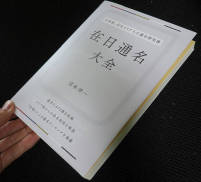Koushiro 【神代】レベル5
About 4,700
The Japanese surnames etymology dictionary.
Kagoshima-ken , Kanagawa-ken · Niigata-ken . Creation . "Light" was added to village which is the surname of Amagi archipelago of Kagoshima-ken . Estimated at the time of returning to Japan in 1953. Kagoshima-ken Ooshima-gun Tokunoshima-chou Distributed in Kameitsu. Where she in the 里 there last name. 里 reference.
2025年 9月 6日 更新
Kakumi 【神代】レベル5
About 4,700
The Japanese surnames etymology dictionary.
Nagasaki-ken Sasebo-shi . A variant of 神応寺 .
2017年 10月 15日 更新
Kakomi 【神代】レベル5
About 4,700
The Japanese surnames etymology dictionary.
Nara-ken Kashihara-shi · Kanagawa-ken . Terrain . From the top house. Nara-ken Kashihara-shi Distributed in Nakoso Town.
2017年 10月 15日 更新
Kashiro 【神代】レベル5
About 4,700
The Japanese surnames etymology dictionary.
Hiroshima-ken Higashihiroshima-shi . Thing . From the crow and the field. Hiroshima-ken Higashihiroshima-shi Distributed in Kurose-cho Tsue.
2017年 10月 15日 更新
Kamiyo 【神代】レベル5
About 4,700
The Japanese surnames etymology dictionary.
Ehime-ken , Fukuoka-ken . A variant of 桐島 .
2017年 10月 15日 更新
Kumashiro 【神代】レベル5
About 4,700
The Japanese surnames etymology dictionary.
Kanagawa-ken Yamato-shi , Ibaraki-ken Sakuragawa-shi . Kanagawa-ken Yamato-shi Kamiyukiyanagi is based. It was in the Edo period in the same place. He said that he was engaged in agriculture and sericulture in the same area.
2017年 10月 15日 更新
Jindai 【神代】レベル5
About 4,700
The Japanese surnames etymology dictionary.
Kagoshima-ken , Miyazaki-ken .
① variant of 田丸 . Changed name from Tamaru surname at Kagoshima-ken . From the Buddhist gates of the gate division system that was in the Edo period. An example of the location of the gate. Kagoshima-ken Satsuma- ken Natsugawa , Kagoshima-ken Kagoshima-shi Ishidani-cho, Kagoshima-ken Minamisatsuma-shi Koneda Murahara, Miyazaki-ken Ebino-shi Saigo. 田丸 reference.
② Kagoshima-ken Minamisatsuma-shi Birthplace originated from Yuri in Shimokawa's small character. On the same day there was a Tadashi gate in the Edo era system.
2017年 10月 15日 更新




